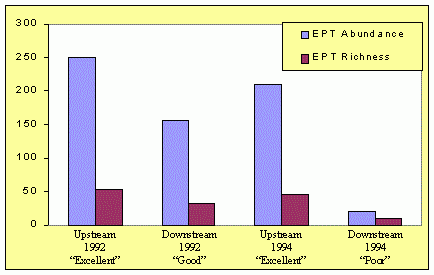Biological Data Implicate Pesticide Contamination in North Carolina
Program Overview
The North Carolina Division of Water Quality (DWQ) has been using bioassessment techniques to evaluate water quality for more than 15 years. The basin-wide management program includes all 17 of the state's major river basins, which are assessed on a 5-year cycle. Macroinvertebrate samples are used to calculate EPT taxa richness and a biotic index; the waterbody is then placed in one of five classification categories from "Poor" to "Excellent." Fish community assessments use an Index of Biotic Integrity (NCIBI), which is based on twelve fish metrics and ranks the waterbody using the same five categories as for the benthos. North Carolina's narrative biocriteria, established to protect aquatic life and assess water quality impairment, have proven especially valuable in supporting decisions to implement management strategies to address impairment. DWQ staff believe that the use of two sets of biological data (benthos and fish assemblages) allows better attribution of the causes of impairment, particularly with respect to non-point source issues. The case study presented below supports this concept.
Tomatoes, Drinking Water, and the Mills River
The Mills River is an important high-quality stream and a potential drinking water supply, with many segments classified as High Quality Waters or Outstanding Resource Waters. The stream had always received either a Good or an Excellent rating based on macroinvertebrate sampling conducted during ambient monitoring over a 13-year period. Thus it was surprising that the August 1994 collection found a dramatic decline in both taxa richness and abundance, and an almost complete absence of intolerant EPT taxa, resulting in a Poor rating. No visible changes in habitat had occurred, and the NCIBI indicated the fish community was not affected. Molluscs also did not appear to be affected. Local land use included nearby tomato farms, and the summer of 1994 had been exceptionally wet, leading to increased use of pesticides. Because only the arthropod invertebrates were affected, the most likely cause was suspected to be the use of insecticides on tomatoes, and further investigation implicated pesticide mixing stations close to the river as the primary source of the problem. Analysis of fish tissue and water samples provided no useful information about the cause, because the suspected insecticides did not show up in samples taken. Thus, in this case, both the detection of the impact and the diagnosis of the cause were accomplished on the basis of the macroinvertebrate data and land use patterns.
Mills River: EPT metrics and overall rating at sites upstream and downstream of tomato farming, 1992 vs. 1994 (adapted from Lenat, 1997).

The detection of this impact and diagnosis of its cause had important human health implications because the Mills River serves as one source of drinking water for the largest population concentration in western North Carolina, and the impacted location was upstream of both an existing and a proposed drinking water intake. These concerns provided considerable incentive for local officials to work with area farmers to solve the problem. Further investigation revealed areas adjacent to the river where pesticide concentrate was mixed with water drawn from the river. A stakeholders group, The Mills River Partnership, was formed to address watershed protection issues, including the pesticide mixing issues. The Partnership includes the cities of Asheville and Hendersonville, Henderson County, Carolina Mountain Land Conservancy, the Regional Water Authority, Henderson Soil & Water Conservation District, the U.S. Forest Service and the Land of Sky Council of Governments. In March, 1999, the partnership was awarded a grant of $730,000 from the N.C., Clean Water Management Trust Fund to address a number of water quality issues within the watershed, including improving riparian buffers, reducing sedimentation, and relocating the pesticide mixing facilities.
Lesson Learned
Biological monitoring, in conjunction with knowledge of land use patterns, indicated the occurrence of a toxic event that would have been missed by reliance on chemical analysis alone. The types of bioassessment data collected made it possible to pinpoint the likely cause and source of the problem.
Additional Information
Trish MacPherson (trish.macpherson@ncmail.net) at NC Division of Water Quality (919-733-6946)
References
Lenat, D., V. Schneider, and M. Hale, 1995. Mills River investigation, October 1994, Henderson County. Memorandum submitted to Ken Eagleson, N.C. Division of Environmental Management, Biological Assessment Group.
Lenat, D., 1997. Mills River sampling, Henderson County, French Broad subbasin 03, July 1997. Memorandum to Jimmie Overton, N.C. Division of Water Quality, Biological Assessment Unit.
